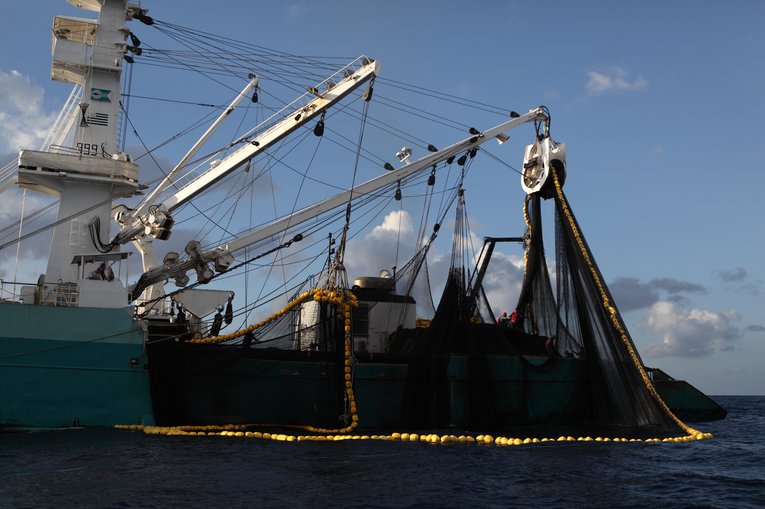
Dolphin bycatch impacts seabass ratings
The Marine Conservation Society has updated its Good Fish Guide ratings and added wild caught seabass from multiple locations to its red and amber-rated lists.
Seabass under threat
The charity has concerns for seabass population sizes and the impact of some seabass fishing methods which are inadvertently catching common dolphins and harbour porpoises as bycatch. The bycatch problem is so severe that local cetacean populations are rapidly declining and could even disappear from the area entirely. As a result, some seabass caught in the southern Bay of Biscay and Atlantic Iberian waters are now red rated and join the charity’s ‘Fish to Avoid’ list.
Dolphins and porpoises are natural predators of seabass, and the Bay of Biscay makes for an excellent hunting ground. Unfortunately, this means that the cetaceans are vulnerable to being accidentally caught in fishing nets and often don’t survive the experience.
Two fishing methods often result in the accidental capture of dolphins and porpoises: static nets and pelagic pair trawling. Static nets are suspended in open water and are difficult, if not impossible, for cetaceans to detect. Animals inadvertently swim into the nets and are quickly entangled, unable to escape or reach the surface to breathe. Static nets catch hundreds of harbour porpoises and scientists fear they could go locally extinct if measures aren’t taken. Pelagic pair trawling, where two boats pull a net through the water between them, uses sonar to target huge shoals of bass but can also catch common dolphins whilst feeding on seabass.

Credit: Jiri Rezac
Thousands of common dolphins are thought to be caught in the Bay of Biscay every year, and there is real concern that this could cause populations to decline in the area.
Until things improve, the Marine Conservation Society recommends that shoppers avoid pair trawled and static net-caught seabass from the southern Bay of Biscay. Certified farmed or line caught seabass are better alternatives.
Dolphin-friendly options
Charlotte Coombes, Good Fish Guide Manager: “When you hear the term ‘dolphin-friendly’ it’s most likely you think of tins of tuna. But why do we reserve our interest in dolphin-friendly seafood for just tuna? By checking how seafood is caught, and getting familiar with different catch methods, you can ensure that all of your seafood is dolphin-friendly, with or without the logo!
“It’s important to consider the wider environmental impacts of the seafood you choose, which is why we encourage consumers to check where and how a species was caught or farmed, and why we outline all of this information in the Good Fish Guide.”

Credit: Peter Bardsley
Reducing the impact of fishing
The environmental impact of fishing is a key consideration in the Good Fish Guide, which is supported by players of People’s Postcode Lottery, and something to bear in mind when making seafood choices. While pair trawling and static nets in the Bay of Biscay are particularly worrying, other methods can also have unwanted side effects. For example, bottom trawling is a very common fishing method for fish such as cod, haddock, plaice and prawns throughout UK seas and beyond. Because trawls are often pulled over the seabed, the worst-case scenario results in animals and delicate habitats being scraped up and damaged.
But some fishers, scientists and regulators are doing excellent work to minimise the impacts of fishing activity. For example, fixing deterrents on to nets can sometimes scare away dolphins and porpoises; some fishers use devices which make a noise, whilst recent research has shown that using LED lights can also work. Meanwhile, avoiding vulnerable habitats and switching to low impact gears can reduce habitat damage.
Sustainable seafood choices
Looking at what species are caught or farmed, using which method and where, the Good Fish Guide provides a traffic light system to illustrate the sustainability of seafood caught or eaten in the UK. Red rated fisheries join the charity’s ‘Fish to Avoid’ list, amber rated options are a ‘Think’ as improvements are needed, whilst green rated are the most sustainable options and considered the ‘Best Choice’.
Farmed king and queen scallops newly join the Good Fish Guide as green rated, Best Choice seafood options in the autumn ratings update. Additionally, North Sea herring moves from the green to amber list due to a sharp drop in population sizes since 2016. Some Dover sole from the eastern English Channel and the Irish Sea move from the amber to green list as population sizes are slowly growing – although sole caught in these areas by beam trawling, a more damaging fishing method, stays on the amber list.
The Good Fish Guide app is available to download, and online at www.goodfishguide.org. The charity’s ‘Pocket Good Fish Guide’ is also available in print.


